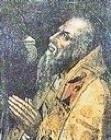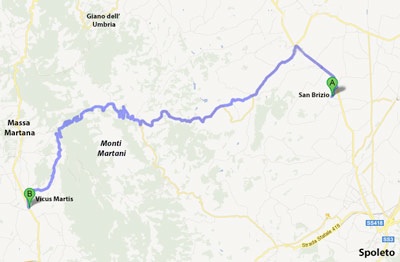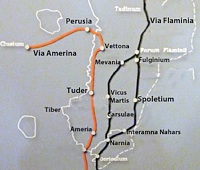
St Brictius
Please be aware that what follows are the speculations of an amateur. If you have a serious interest, you would do well to consult the sources referenced below.
By far the largest portion of the Legend of the Twelve Syrians relates to St Brictius. This page analyses this central portion of the legend.
Martyrology of Florus
An entry under 9th July in the Martyrology of Florus (825-40) contains a summary of the legend of St Brictius:
-
✴He was a bishop (of an unspecified diocese) who was imprisoned and tortured by the judge “Martiano”.
-
✴He escaped martyrdom when Martiano was among those killed in an earthquake.
-
✴Christ sent St Peter to comfort and encourage him, together with an angel who led him safety.
-
✴He continued his ministry and died in peace at Civitate Martulana.
-
✴Those attending the death saw his soul, in the form of a dove, fly up to heaven.
This account does not specify when these events unfolded. However, since the martyrology contains a similar entry for two other saints, SS Carpophorus and Abundius, who were also imprisoned by the judge Martiano in the Duchy of Spoleto, it is reasonable to assume that St Brictius was imprisoned at about the same time: i.e. during the period of persecution unleashed by the Emperor Diocletian in 303.
Legend of the Twelve Syrians (BHL 1620)
Introductory Section
As set out in the page Legend of the Twelve Syrians I, the first part of that legend explains (inter alia) how St Brictius came to be in the Duchy of Spoleto:
-
✴He was a member of the party that his father, St Anastasius, led from Syria to Rome.in the reign of the Emperor Julian the Apostate (361-3).
-
✴When the party arrived in Rome, a bishop named Urban (“ss. Urbano episcopo”, “ss. papa Urbano” or other variants thereof) ordained St Brictius as a priest.
-
✴When St Anastasius was executed, St Brictius led the rest of the family to safety along Via Cornelia.
-
✴Two of the Syrians left the group at a place called “Pax Sanctorum”. St Brictius and the rest of the family continued to Spoleto.
There is no reason to think that this section of the Legend of the Twelve Syrians drew on the same source as the Martyrology of Florus, which:
-
✴does not mention the rather important fact that St Brictius was from Syria; and
-
✴is almost certainly set some decades before the reign of Julian the Apostate.
Rest of Part I
The rest of Part I is mostly concerned with the martyrdom of SS Carpophorus and Abundius, two other members of the family who arrived in Spoleto with St Brictius. The proconsul Martiano arrested them following the publication in Spoleto (according to this legend, and perfectly plausibly, on 23rd July) of the anti-Christian edict (303 AD) of the Emperor Diocletian. They and their followers were subsequently martyred. (This part of Part I is discussed in the page Legend of the Twelve Syrians IV).
St Brictius escaped this fate of because an angel led him to safety at a place in the suburbs of Spoleto called “Apianum”. The angel appeared again after three nights and led him to “locum salutis” (a place of safety). On the way, St Brictius cured a blind pagan called Pisentius, who consequently embraced Christianity. He then continued to this safe location, which he called “Salustianum”, and built an oratory there “with his own hands”.
It seems highly likely that this section of the Legend of the Twelve Syrians drew on the same sources as the Martyrology of Florus for the information on St Brictius (and for that on SS Carpophorus and Abundius).
Part II
Part II deals almost exclusively with St Brictius:
-
✴When the proconsul Martianus heard that St Brictius was still at large, he sent soldiers to arrest him at the oratory at Salustianum. He was tortured and imprisoned, but his suffering was cut short when Martianus was killed in an earthquake that struck his palace. St Peter appeared to the incarcerated St Brictius ....
-
✴.... and conferred on him powers to ordain bishops in every city.
-
✴An angel then took St Brictius back to Salustianum, telling him that he would live here until his death after 45 years.
-
✴St Brictius led a group of Christians to a place called “Mariano”, where he built a second oratory, which this time was dedicated to the Virgin. It was here that he made the episcopal appointments discussed below.
-
✴The account is then interrupted by a paragraph on the fate of St Herculanus, one of these episcopal appointments.
-
✴The account of St Brictius’ life resumes in one of his oratories (it is unclear which one - see below), where he built a burial chamber with his own hands.
-
✴An angel appeared to him at Easter to announce his imminent death.
-
✴He died on 9th July, and the onlookers saw his soul fly to heaven in the form of a dove.
Francesco Lanzoni (at page 429 in the book referenced below) suggested that Part II was a later addition to the legend. To take this further, it is interesting to consider separately the three bullets here that are in italics:
-
✴The first of these seems to be a natural part of the earlier material that shared its source with the Martyrology of Florus.
-
✴The bullet on St Herculanus, which is drawn from the Dialogues of Gregory I and set in the 6th century (as discussed in the page Legend of the Twelve Syrians V), is clearly an addition.
-
✴The last bullet sits uneasily with the one before it: an angel appears to St Brictius at Easter to announce his imminent death; and he dies in July. It seems likely that these two bullets came from separate sources, and specifically that the second of them originally belonged at the end the section that shared its source with the Martyrology of Florus.
It is entirely possible all of the bullets not in italics came from a separate (and quite possibly from a later) source.
Passio s. Britii (BHL 1622d)
Two copies of the legend of St Brictius (Passio s. Britii - BHL 1622d) are included in the Leggendari del Duomo di Spoleto, both under 9th September [why ??]:
-
✴one from San Brizio (see below); and
-
✴one from the Abbazia di San Felice di Narco.
These copies contain no new information, but the order in which St Brictius built his two oratories in the Monti Martani is reversed (see below).
Analysis of BHL 1620 and BHL 1622d
Oratories of St Brictius

In Part I of BHL 1620, St Brictius preached in “omnibus regionibus sub montana Martulanæ” (all the regions under the Monti Martani). He converted many people to Christianity, and he built a small oratory in a place that he called Salustianum. This is the last mention of St Brictius in Part I. As noted above, it seems likely that the sentences at the end of of Part II, which relate to his death in July, originally belonged here, thus ending the legend. If so, it would follow that St Brictius died and was buried at Salustianum.
On the basis of this information in Part I, it would be reasonable to assume that Salustianum was near Civitas Martana, to the west of the Monti Martani, a place that recurs in the legends of a number of saints. A vibrant Christian community had developed here by at least the 4th century on the site of a way station on the old Via Flaminia called Vicus Martis (see map). This settlement was destroyed in the late 5th century, and the surrounding region (which might have been a small diocese) was split between the dioceses of Spoleto and Todi. The Lombards subsequently fortified a site slightly to the north of it that is still known as Massa Martana.
Part II (which, as noted above, may be a later addition) begins with a paragraph on the arrest of St Brictius at his oratory at Salustianum that is quite specific about its location:
-
✴Informers told Martianus that St Brictius was in hiding in “Civitate Martulana”.
-
✴He sent soldiers to St Brictius’ oratory, some six Roman miles from Spoleto, “in territorio Salustiano in superiori via in vertice collis” (in the territory of Salustianum, on the upper road, at the top of the hill).
Thus the author of Part II placed the oratory much closer to Spoleto than Vicus Martis. He was almost certainly referring to the site to the east of the Monti Martani where the present church of San Brizio was later built: a sarcophagus in the crypt there is believed to have housed the relics of St Brictius.
St Brictius returned to Salustianum after his escape from prison, and the angel told him that he would live there until his death after 45 years. He subsequently built a second oratory, which was dedicated to the Virgin, at a place called “Mariano”.
-
✴This is sometimes thought to be modern Maiano, which is 3 km south of San Brizio (and, perhaps significantly, 1 km east of the village of Sant’ Anastasio).
-
✴However, it is possible that “Mariano” was a distortion of “Martano” or “Martulano”. The author of Part II could have introduced this second oratory to address the tradition linking St Brictius to Civitas Martana [and perhaps to the ancient church of Santa Maria in Pantano, which stands on the site of Vicus Martis].
It was at Mariano that St Brictius made the episcopal appointments discussed below.
The narrative is then interrupted by the excursus mentioned above that deals with St Herculanus. It resumes with St Brictius “in modico oratorio suo” (in his small oratory), although it is not clear which of the two this was. He built his tomb there and died there on 9th July.
As mentioned above, the author of the Passio s. Britii (BHL 1622d) has a different account of the sequence in which St Brictius built his two oratories.
-
✴This account does not specify where St Brictius was when he was arrested, but the angel that appeared to him in prison after the death of Martianus lead him to “the [unidentified] place to which he had taken him before”. This angel told him that he would die there after 45 years.
-
✴St Brictius then built his oratory at Mariano, and his tomb inside it. Once more, it is at Mariano that St Brictius made the episcopal appointments discussed below.
-
✴The angel appeared to him there and took him to “the place of salvation”, which was (like Salustianum in BHL 1620) on the upper road, at the top of the hill. The angel told him that this would be his home until the day of judgement. St Brictius built his second oratory here, at the place that he called Salustianum “because the salvation of his soul had begun here”. The account concludes with another description of the location: “Montuosis subiacet leni elati” (at the foot of the mountains, on a small hill).
Thus, unlike the author of Part II of BHL 1620, the author of BHL 1622d is very clear that St Brictius died at Salustianum, which he presumably associated with San Brizio.
In each account (BHL 1620 and BHL 1622d), the author seems to struggle to reconcile two traditions:
-
✴the tradition in the martyrologies that St Brictius died at Civitas Martana; and
-
✴the presence of his presumed sarcophagus at San Brizio.
One possibility is that the relics had been translated across the Monti Martana to San Brizio when Civitas Martulana faced destruction.
There is no direct evidence for this hypothesis, but parallels might be drawn from the history of the relics of of St Felix, the only known bishop of Civitas Martana:
-
✴Silvestro Nessi (referenced below) draws on an entry in the Legendary of Farfa (9th century) that refers to the translation of the presumed relics of St Felix to what became the Abbazia di San Felice at Giano dell’ Umbria (see map) in the diocese of Spoleto.
-
✴He also refers to a later version of this legend, in which Bishop John of Spoleto dedicated an altar at San Felice di Giano to St Felix, and suggests that the translation and the dedication of the altar would have happened at the same time. As he points out:
-
•a bishop of Spoleto called John is securely documented in ca. 500, a time close to the date of destruction of Civitas Martana; and
-
•the legend (10th century) of St John Penariensis also features a bishop of Spoleto called John, who is killed during the occupation of Spoleto by the Goths (i.e. in 545-7).
-
This means: either that Bishop John I reigned for some 50 years; or that there were two bishops of this name in the first half of the 6th century.
-
✴Silvestro Nessi dates the presumed sarcophagus of St Felix, which survives in the crypt of San Felice di Giano, to the middle of the 5th century. Luigi Sensi (referenced below) places it among a number of sarcophagi of this type in the region that were apparently used to house the relics of saints.
If the relics of St Brictius were also in Civitas Martana when the city was threatened by destruction, they might well have been translated to a safer location such as San Brizio. Gisberto Martelli (referenced below) asserts that the crypt of San Felice di Giano formed a prototype for those of a number of other churches in the area, including that of San Brizio. This could be because they were built for a similar purpose: to receive the relics of saints.
The hypothesis of a translation of the relics of St Brictius from Civitas Martana to San Brizio is by no means proven. (Note, for example, that crypts at San Brizio and San Felice di Giano seem to have been built in the 10th or 11th century, and that the sarcophagus at San Brizio is not of the type at San Felice di Giano). Nevertheless, the idea does provide an explanation for the presence of two oratories in the tortuous narrative of Part II of BHL 1620 and of the Passio s. Britii (BHL 1622d). It could also explain why the latter appears under 9th September in the Leggendari del Duomo di Spoleto (in two editions, one from San Brizio and one from San Felice di Narco): this could have been the date of a translation.
St Brictius and the Episcopal History of the Duchy of Spoleto
The Legend of the Twelve Syrians has a lot to say about the episcopal history of the Duchy of Spoleto. The first issue to address is the position of St Brictius himself:
-
✴The early martyrologies describe him as a bishop (without specifying his diocese) who died at Civitate Martulana some time after 303 AD (the date of the death of the judge Martiano).
-
✴In the Legend of the Twelve Syrians, he was ordained as a priest by a bishop of Rome (leaving aside for the moment the difficulties with the timing of this event). During his imprisonment in 303 AD, St Peter conferred on him the “ordine pontificatus, ut per singulas civitates episcopos ordinaret” (order of the pontificate, in order to ordain bishops in every city). He subsequently ordained at least four bishops (see below), before dying after 45 years spent in the foothills of the Monti Martani.

-
✴Spoleto (“Metropoli civitati Spoletinæ”), where his appointee, St John, built the huge church of San Pietro near the mountains outside the city;
-
✴Bevagna, where he appointed St Vincent;
-
✴Bettona, where he appointed St Scipiodotus (see St Crispoltus), who is described, somewhat enigmatically, as “sicut eum B. Petrus Apostolus docuit” (he whom St Peter the Apostle taught); and
-
✴“even at the city of Perugia”, where he appointed his nephew St Herculanus, who earned the palm of martyrdom.
It seems therefore that the legend claimed a metropolitan area for St Brictus that:
-
✴extended across the Duchy of Spoleto, taking in Spoleto and Bevagna on the separate arms of Via Flaminia;
-
✴and also included two cities that were on the Via Amerina: Bettona; and “even” Perugia.
If we assume that Spoleto was at the centre of the archdiocese, claims for episcopal authority are not particularly surprising in relation to Bevagna and Bettona:
-
✴Bevagna was a separate diocese in 487, when its first known bishop, Innocentius, attended a synod in Rome. In a letter to Bishop Chrysanthus of Spoleto in 597, Pope Gregory I lamented the fact that this diocese had been without a bishop since 571 and requested that he take over its administration. It is clear from a second letter to Bishop Chrysanthus in 599 that the diocese was still in crisis. Separate Bishops of Bevagna are recorded again in 649 and in 680 (when Bishop of Bevagna accompanied the Bishop of Spoleto to a synod in Rome), but the diocese then passed definitively to Spoleto.
-
✴Bettona was a separate diocese in 465, when its first known bishop, Gaudentius, attended a synod in Rome. It became part of the Duchy of Spoleto after the original Lombard invasion, and, although forces from Perugia were able to incorporate it into the Byzantine corridor between Rome and Ravenna in the early 590s, it subsequently reverted to the Duchy of Spoleto. Its diocese seems to have been incorporated into that of Assisi, another diocese of the duchy, in ca. 600.
However, as the author of the legend recognises, it is very surprising that “even Perugia”, one of the most important cities claimed by the papacy, was included within the authority given to St Brictius. To take this aspect further, it is necessary to say more about St Herculanus and the diocese of Perugia. [More]










